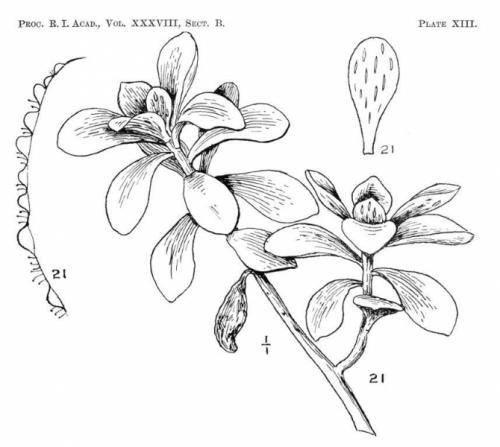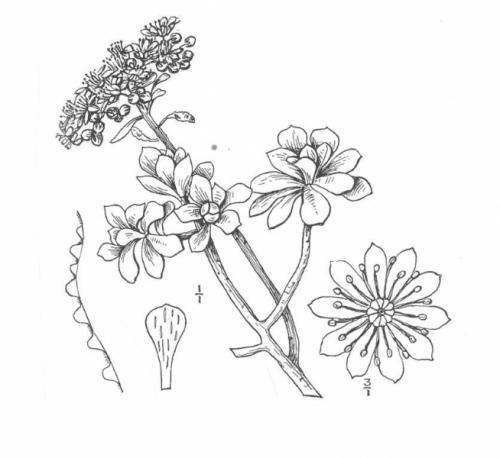x rowleyi Bramwell, 1973
Par: Aeonium smithii (Sims) Webb & Berthel. × Aeonium spathulatum (Hornem.) Praeger
Sempervivum smithii Sims × Sempervivum strepsicladum (Webb & Berthel.) Webb ex H.Christ, Bornmüller, Ergebnisse zweier botanischer Reisen nach Madeira und den Canarischen Inseln. In Engler, A., Botanische Jahrbücher für Systematik, Pflanzengeschichte und Pflanzengeographie 33(3): 432. (8 Dec) 1903 (without description).
Aeonium smithii (Sims) Webb & Berthel. × Aeonium spathulatum (Hornem.) Praeger, Praeger, Semperviva of the Canary Islands area, Proceedings of the Royal Irish Academy 38 Sect.B (1): 481, t.13. (24 Sep) 1929.
Aeonium ×rowleyi Bramwell, in Jacobsen & Rowley, Some name changes in succulent plants, Part V., National Cactus and Succulent Journal 28: 5. (Mar) 1973.
Etym: Named for the English botanist Gordon Douglas Rowley (1921- ).
T: Islas Canarias, Tenerife, Vilaflor; 1924, R. Lloyd Praeger.
HT: Sketch of a branch & leaf, in Praeger, Semperviva of the Canary Islands area, Proceedings of the Royal Irish Academy 38 Sect.B (1): t.13, fig.21. (24 Sep) 1929.
Obs: There were 2 original elements: Praeger's sketch & Murray's BM specimen, from which Praeger chose his sketch to represent the type: "The Vilaflor plant [fig. 21] is more intermediate between the parents, and I take it as type".
Praeger also reported a quite different form in the barranco El Valle above Güimar, while Bañares (1995) found it in the Barranco de Tabaiba.
An erect slightly branched subshrub 30 cm high.
Branches erect, 4 - 5 mm thick, glabrous (not hairy), leavy above.
Leaves rhomboidal-spathulate or spathulate, 3 - 6 x 1.5 - 2 cm, surface rather wavy, shining, back marked with green (ultimately blackish) immersed glands, shortly and thickly glandular-pubescent on face and back, margin mammillate and ciliate, the pellucid mammillae chiefly near the apex, the glandular cilia chiefly towards the base.
Flowering branches 4 -5 cm long, very leafy.
Inflorescence and flowers intermediate.
Flowering time : May.
Habit of spathulatum but more vigorous. Rosettes larger and laxer, without the closed leaf-buds of spathulatum. Glands on back of leaf longer than in spathulatum ; in all these characters tending towards smithii.
A second form, found at El Valle above Güimar, Tenerife, was half-way between the above hybrid and spathulatum, a smaller more compact plant, nearer spathulatum. Leaves light green, but broader and more persistent in summer than in spathulatum, finely glandular-pubescent (as in spathulatum), not hairy, with beaded lightly ciliate margins ; inflorescence like spathulatum, but the flowers large, nearly of the size of those of smithii, and petals broader than in spathulatum (Praeger 1929).
The remarkable coarse hairs of the stem of smithii are lost in both forms of the hybrid.

Aeonium ×rowleyi LT image from Praeger, Semperviva of the Canary Islands area, Proceedings of the Royal Irish Academy 38 Sect.B (1): t.13, fig. 21. (24 Sep) 1929.

Form from El Valle above Güimar, closer to A. spathulatum.
Sketch from Praeger, Semperviva of the Canary Islands area, Proceedings of the Royal Irish Academy 38 Sect.B (1): t.13, fig. 22. (24 Sep) 1929.